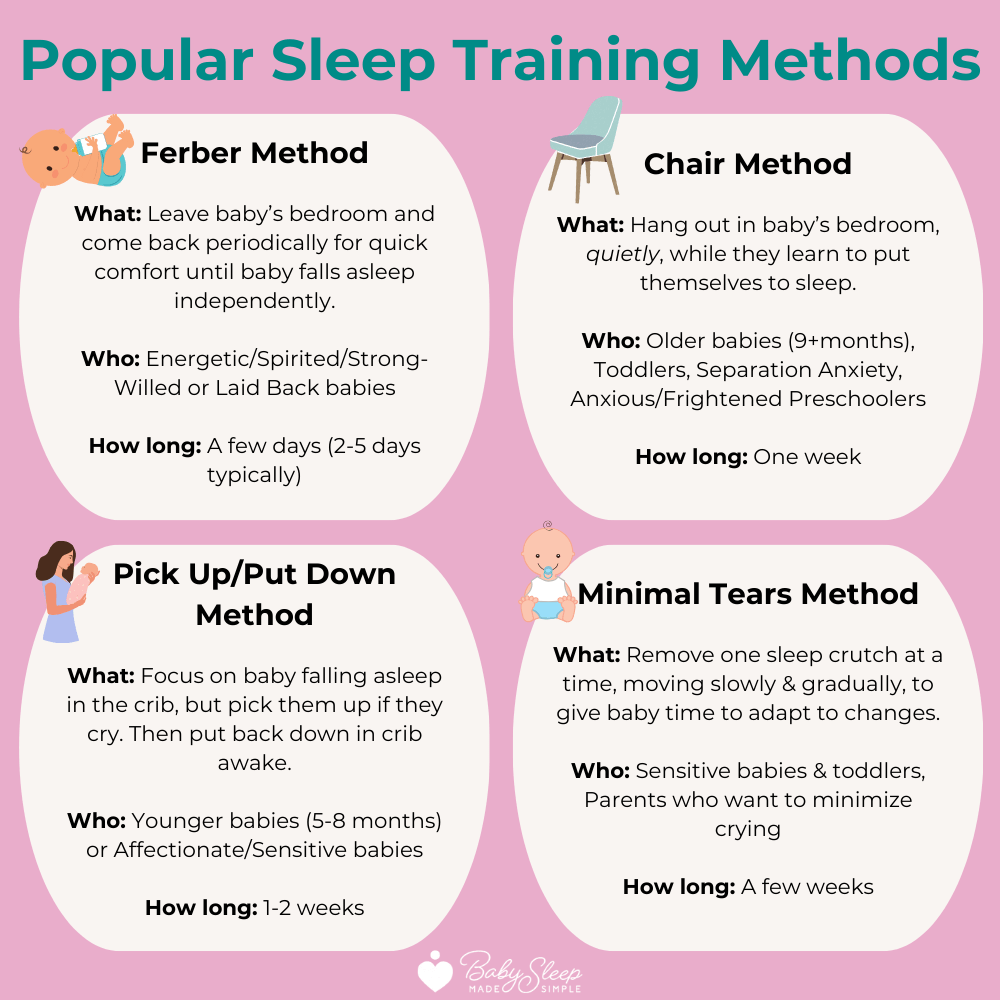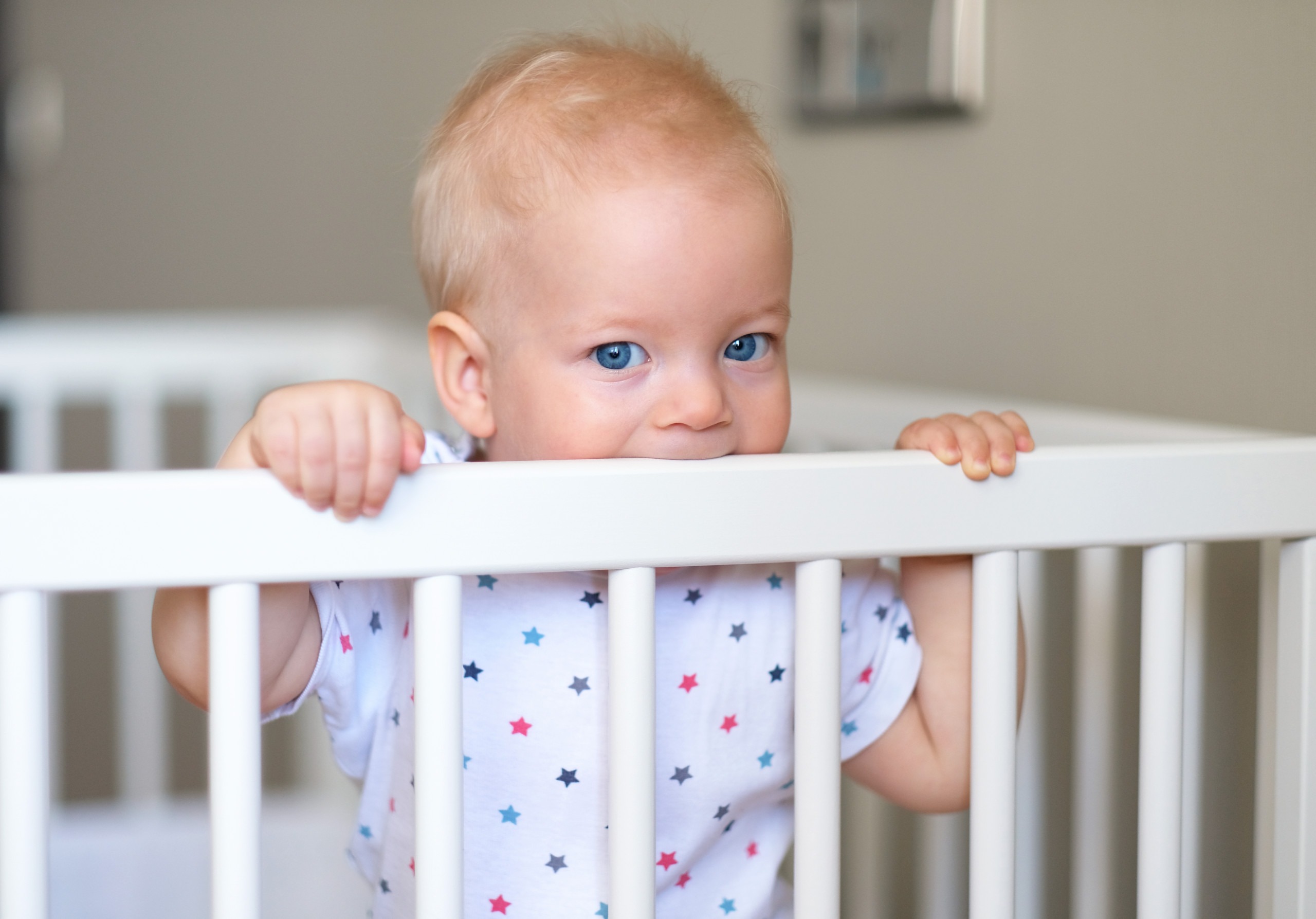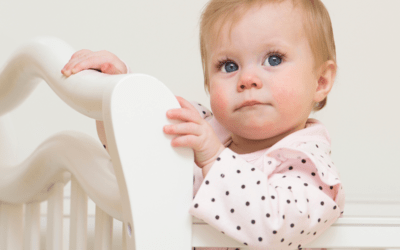Sleep training is the process of teaching your baby or toddler to sleep independently, so they can get the long and restful sleep they need to grow and thrive. Parents all over the world credit sleep training with giving them a full night’s sleep, improving their physical and emotional health and, sometimes, saving their sanity!
So, how do you do it when there seems to be a myriad of sleep training methods and endless opinions on which one is best?
This blog post breaks down the most popular and effective sleep training methods for babies and toddlers (methods that my team and I have used to help thousands of families get better sleep). It gives you specifics on methods including Ferber, pick up put down, chair method and gentle sleep training, and helps you decide on the best sleep training method for your baby.
Table of Contents:
Popular sleep training methods
Pick up / Put Down Sleep Training Method
Cry it Out Sleep Training Method
Popular sleep training methods
First, if you want to know more about what sleep training is, and the best age to begin, check out my blog post on What is Sleep Training?
This blog post assumes that you already have the background of why sleep training works, and now you’re wondering how to find the best sleep training method for your baby or toddler.
And more specifically, how in the world you’re going to get your baby happily falling asleep on their own every night!
Maybe you’ve tried placing your baby in the crib awake and they cried or screamed, so you quickly picked them up and helped them fall asleep. It probably felt too upsetting or stressful to try again. That makes perfect sense.
Most parents want their baby to sleep through the night, but they’re not sure they want to sacrifice tears or stress to achieve this.
What I’ve found through my years of working with thousands of families is that there are many effective sleep training methods, and sleep training is most successful when parents are able to pick the best sleep training method for their baby.
For example:
- Some babies adapt easily to the Ferber method of sleep training. It works well for their temperament or specific situation.
- Other babies need a parent to stay in the room in order to be calm enough to fall asleep in a new way.
- And there are babies who need a slow entry to sleep training, with lots of hands-on help, in order to learn a new, independent sleep routine.
Here’s a sleep training truth I’ve discovered over the years:
The best sleep training method is the one that’s well-suited to your baby’s age and personality.
And here’s another one:
When parents find a sleep training method that’s aligned with their goals and doesn’t go against their parenting instinct, they are more committed and consistent, which leads to sleep training success.
So let’s discuss a few popular and effective sleep training methods now.

Ferber method sleep training
The Ferber method of sleep training is popular, effective and sometimes controversial. Dr. Richard Ferber literally “wrote the book” on this method explaining that leaving your baby for short periods of time helps them learn to fall asleep on their own and sleep through the night.
With the Ferber method of sleep training, you typically remove all sleep props at once. If your baby is used to nursing to sleep, taking a pacifier or being rocked, you would stop all sleep props on the first night. After a relaxing bedtime routine, you place your baby in the crib awake, give them a kiss and leave the room.
Parents can go in to quickly check on their baby every few minutes. Picking their baby up or helping them fall asleep isn’t allowed. As you may imagine, the Ferber method usually involves crying. It’s normal for babies to cry in protest when changing their sleep habits. They don’t understand this new routine and they’re not happy with not being helped to sleep.
The Ferber sleep training method is controversial because some parents don’t believe in leaving a baby on their own to cry in order to learn independent sleep habits. Other parents praise this method with getting their baby sleeping through the night in a matter of days and crying less in the long-term.
In my experience, I’ve found the Ferber method of sleep training to be highly effective. Especially when used with easy going or energetic babies and toddlers.
If you want a step-by-step guide for using the Ferber method to get your baby sleeping through the night, we include it in my baby sleep program here.
Do you feel anxious or scared about the thought of your baby crying during sleep training?
Or do you worry that sleep training might harm your baby?
This blog post investigates if sleep training is harmful and includes high-quality research studies.
Chair method sleep training
Sleep training using the chair method involves parents “camping out” in their baby’s bedroom. Rather than leaving the bedroom, parents sit in a chair quietly while their baby learns a new way of falling asleep.
In its truest form, it’s a hands-off method. Parents are meant to sit quietly and not pick their baby up or help them fall asleep. Singing or shushing is ok for a few days.
What’s imperative for making the chair method successful is you have to move your chair away from your baby’s crib. Each night you move a few feet closer to the bedroom door. Once you’re there, you spend a few nights popping out of your baby’s bedroom for them to fall asleep on their own.
Many parents love chair method sleep training because they get to stay with their baby or toddler as they teach a new sleep routine. Listening to your baby cry and not being able to soothe them can be upsetting, though, so this method isn’t for everyone.
I’ve found the chair method sleep training to be especially effective for babies and toddlers who are experiencing separation anxiety. (It’s included in my sleep program here.)
Some babies need a few nights to warm up to chair method sleep training, they need some hands-on help to get the process started. This is something I help parents with in my sleep training program, 21 Days to Peace & Quiet.
Pick up put down method
The pick up put down method of sleep training is very hands-on. Its name gives it away. You pick your baby up when they’re upset and put them down in the crib once they’re calm.
Sounds easy enough, but I’ve found that the small details of this method can literally make or break sleep training. Specifically, you pick your baby up less each day so they can learn to fall asleep on their own.
I’ve found that the pick up put down method is not suited well to toddlers or high energy babies. Too much hands-on help excites them and they think it’s a game. Or they get very frustrated not being helped to sleep in their usual way.
The pick up put down method of sleep training is great for babies younger than 9 months or sensitive and affectionate babies.
If you want a step-by-step guide for using pick up put down to get your baby sleeping through the night, it’s included in my baby sleep program here.
Gentle sleep training
With gentle sleep training, you go slowly and remove one sleep prop at a time. The idea is that you’re giving your baby time to adapt slowly to changes in their sleep routine.
Let’s say you normally rock and feed your baby to sleep. First, you might choose to stop feeding to sleep but continue rocking. Once your baby is used to that, you would stop rocking to sleep and instead hold them until they fall asleep. Next, you would get your baby used to falling asleep in the crib. You might use hands-on help for a few days to ease this adjustment.
The idea behind gentle sleep training is that you slowly change your baby’s sleep habits so that they resist or cry less. This works well for babies who don’t adapt to change very easily.
I’ve created a unique sleep training method called ‘Minimal Tears’ in my sleep training program. I call it this because I can’t promise “no cry” sleep training (no one really can.) It’s normal for babies to fuss, whimper or push back when changing sleep habits. But, what I help parents do is move slowly, so their baby has time to adapt, which lessens their overall stress and push back.
Most parents love the idea of gentle sleep training. “I can get my baby sleeping through the night without tears? Let’s do it!” But the truth is that gentle sleep training isn’t for everyone. Patience and dedication are critical for gentle sleep training to work.
Gentle sleep training takes several weeks to see big improvements, and for many parents, this is too long.
If you feel like you’re at your wit’s end and need your baby to start sleeping better in a few days, gentle sleep training isn’t your best option. And that’s ok! We all start at different places.
Cry it out sleep training
Cry it out sleep training is a tricky phrase because it doesn’t have an official definition. Some parents think any crying while teaching your baby to sleep independently qualifies as cry it out sleep training. While other parents think that you have to leave your baby’s room and not return for the entirety of the night to qualify as cry it out sleep training. So for these reasons, it can be tricky and confusing for parents and often gets a bad name.
Here at Baby Sleep Made Simple we define cry it out sleep training to be the same as extinction sleep training, which means that after your baby’s bedtime routine when they are fed, clean and ready for sleep, you put them in the crib, leave the room and do not return until the morning.
I understand that some parents use this as a last resort, and in rare circumstances some of my clients have chosen to do cry it out sleep training on their own. I don’t judge parents for using cry it out sleep training. But for those wanting to use a different sleep training method, there are plenty of options to choose from.
In general my team and I have found after helping thousands of families that sleep training goes best when parents are able to choose the best sleep training method for their baby or toddler’s age, personality, energy levels and unique situation.
In fact, it’s what our sleep training programs are all about- personalization and options! You can find the best sleep training program for your baby or toddler here.
The best sleep training program for your baby or toddler
To sum it up, the best sleep training program for your baby or toddler is the one that considers their age, their personality, their energy levels, your family routine (e.g. your child goes to daycare, or has siblings), and also your parenting preferences.
You’ve probably noticed online that many sleep training programs do not consider all of these factors and instead promote one sleep training method to all families worldwide.
What makes Baby Sleep Made Simple stand out is that we consider all of these factors when delivering the best sleep training programs to families.
The best sleep training program is one that is truly flexible, customizable and really listens to your needs as a parent.
Baby Sleep Made Simple offers all of this, especially with our option to add personal support where you can work with our team of professional sleep consultants to ensure that your specific sleep goals are met.
If you have a newborn click here for our one-on-one sleep coaching.
If you have a 5-23 month old click here for 21 Days to Peace & Quiet.
If you have a 2-6 year old, click here for Big Kid Sleep Made Simple.
You’re just one click away from sleeping through the night!
FAQs
Which sleep training method is most effective?
There are a range of effective sleep training methods and the best one for your baby should match their age, personality and your preferences as a parent. We offer this in our sleep programs here.
What are the best sleep training methods for babies?
Popular methods like the Ferber, chair method, pick up put down and gentle sleep training are effective with helping babies learn to sleep through the night.
What is the fastest sleep training method?
In our work with families, the Ferber method sleep training takes 3-5 days for babies to sleep through the night, making it the fastest sleep training method.
How quickly does Ferber method work?
Most babies start sleeping through the night within 3-5 days of starting the Ferber method sleep training.
How long does the chair method sleep training take?
In our work with families, the chair method takes 5-14 days for babies to start sleeping through the night.
Is the chair method effective?
The chair method of sleep training is highly effective, especially when parents have step-by-step nightly guides that walk them through the process like we offer in our sleep programs here.
How does pick up put down method work?
Pick up put down works like this: you pick your baby up when they’re crying and put them down in the crib once they’re calm. Each night you encourage your baby to stay in the crib longer. Our sleep program has detailed step-by-step guides for this method.
What is the gentlest method of sleep training?
Our Minimal Tears method is the gentlest and most gradual sleep training method. It focuses on one sleep prop at a time and aims to minimize your baby’s resistance and crying while learning independent sleep habits.
















Hi,
How does the camping out/chair method work with a toddler who stands up all the time in their crib? Do you just ignore it or keep telling them to lie down/physically lay them down?
Hi Rebecca,
We have several solutions for this in our sleep program:
https://www.babysleepmadesimple.com/baby-sleep-consultant/
We’d love for you to join us and sleep train with step-by-step guides on everything sleep training related.
I know it’s tough when our little ones are resisting bedtime like it’s their full-time job! We’d be happy to help you through it.
Kind regards,
Artemis, BSMS Support Team
I am trying the camping method with my 15 month old. Should I resettle her at night wakings or sit in the same position as the beginning of the night until she cries herself to sleep again? I don’t know if she will get used to me patting her again if I do this during night wakings. Thanks
Hello! While you are sleep training, use the same method for any night wakings that you are using in the beginning of the night. Follow those same steps! Alyssa, BSMS Support team
i have a 7month old boy. Does not nap well during the day at all, sleeps for 30 mins at lunch. by dinner time he is not eating properly as too tired and after bath and massage has to be fed and rocked to sleep. sometimes takes up to 1 hour to settle him as he keeps waking when i put him down.
ends up in my bed with me when he wakes up multiple times during the nigth as im back at work and just desperate to sleep. please tell me your prgram will help with my stubborn little man!
Hi Sophina, our program can definitely help you and your LO. We help clients every day solve issues like this. You can get more info here https://www.babysleepmadesimple.com/21-days-to-peace-quiet-program/ or you can write us at support@babysleepmadesimple.com if you have any question at all. Micaela BSMS Support Team
Have 12 nights on CIO method for 5-12mins crying, when will the crying stop? My baby girl is already sleeping 11-12 hours all night with some wake ups, few mins of complaining and going back to sleep again.
Hi Rocio, since you are not one of our clients and I don’t know all the details of your sleep training journey, I’m gonna give you a general answer just to clarify things a little bit more. When using a quick method (like CIO or Ferber), it’s not uncommon for little ones to fuss as they fall asleep. Sometimes they just need to “blow off some steam.” Many parents tell us it takes several weeks for their babies to stop crying at bedtime. BUT they also say that the crying is minimal and their baby continues to sleep well all night long.
Micaela BSMS Support Team
What program is best for a predictable baby? I do not see that kind of baby in this article 🙂
Hi there Sayuri. Yes, of course our program applies for predictable babies. Once you join the program you can find out which method best suits your and your baby’s needs.
Also, if you haven’t already, you can sign up for our free Exhausted Mom’s Survival Kit, a step by step guide that will help you create healthy sleep habits for your baby, create a bedtime routine, set the right bedtime and help your LO sleep better day & night, overall. Here’s the link –> https://www.babysleepmadesimple.com/exhausted-moms-survival-kit
Hope this helps. Panagiota, BSMS Support Team
signed up for the guide tonight. Little one is 5.5 months old. Breast feeds laying down in our bed, co-sleeps. Seeks the breast all night to soothe back to sleep. Mom is UNCOMFORTABLE! Baby fights all naps and bedtime. Must be breastfed laying down to fall asleep at all. Dad can sometimes rock to sleep, but she will wake immediately if put down (if he keeps holding her, she will sleep up to 1hr+) Crib is in our room. How do we even start??
Hello Miya,
Thanks for your message! We are glad that you signed up for the guide! That is a great first step. I would follow all of those steps first and be super consistent. Then after completing those first few lessons, I would work on going away from colseeping and breastfeeding to sleep. If you are looking for step by step guidance, definitely check out our 21 Days to Peace and Quiet program. Definitely don’t stress. I was in your shoes at 5.5 months and I joined Jilly’s program. My daughter started STTN around 6 months and falls asleep independently. You can get there!! 🙂 Alyssa, BSMS Support Team
https://www.babysleepmadesimple.com/sleep-training-5-month-old-baby-tips
https://www.babysleepmadesimple.com/21-days-to-peace-quiet-program
I’m almost ready to start sleep training my 4.5 month old. She sleeps in the bed, and I nurse her to sleep laying down. My husband is able to rock her to sleep and sometimes put her down in her crib while she is sleeping, but I’m not. This baby is stubborn and fights every bedtime and nap with tears no matter what we do (we have a PNR and we watch wake windows). I’m ready to get her out of my bed because I’m dont sleep well with her in the bed, plus she’s gone from one night waking to 4-5 recently with teething and a sleep regression. My question is, is it worth it to try to break her sleep associations before we start sleep training? Or would it be best to make all the changes all at once, based on her personality? For a very strong willed baby that is still young, what method would you recommend? Thank you!
Hello and thank you for your message! We recommend sleep training after 5 months, so your LO is definitely close. It is okay to continue to nurse until you start training. I would recommend signing up for our FREE Exhausted Moms Survival Kit. You can start to implement all of these lessons now to prepare your LO for sleep training and breaking sleep associations. The chair method and pick up put down are great methods if your LO needs you a little bit more and is on the younger side! Alyssa, BSMS Support Team
https://www.babysleepmadesimple.com/exhausted-moms-survival-kit
I’ve been reading your information about the different ways of sleep training and if I was to try the Ferber method I was just wondering what are you supposed to do through the night when they are still waking up and crying for comfort +/- feed until they are happily sleeping through?
Hello Nicola,
If you choose to use the Ferber method, you will use the steps for the beginning of the night AND any night wakings before 6am. You will follow those steps to help your LO fall asleep independently and resettle in the middle of the night!
Best,
Alyssa, BSMS Support Team